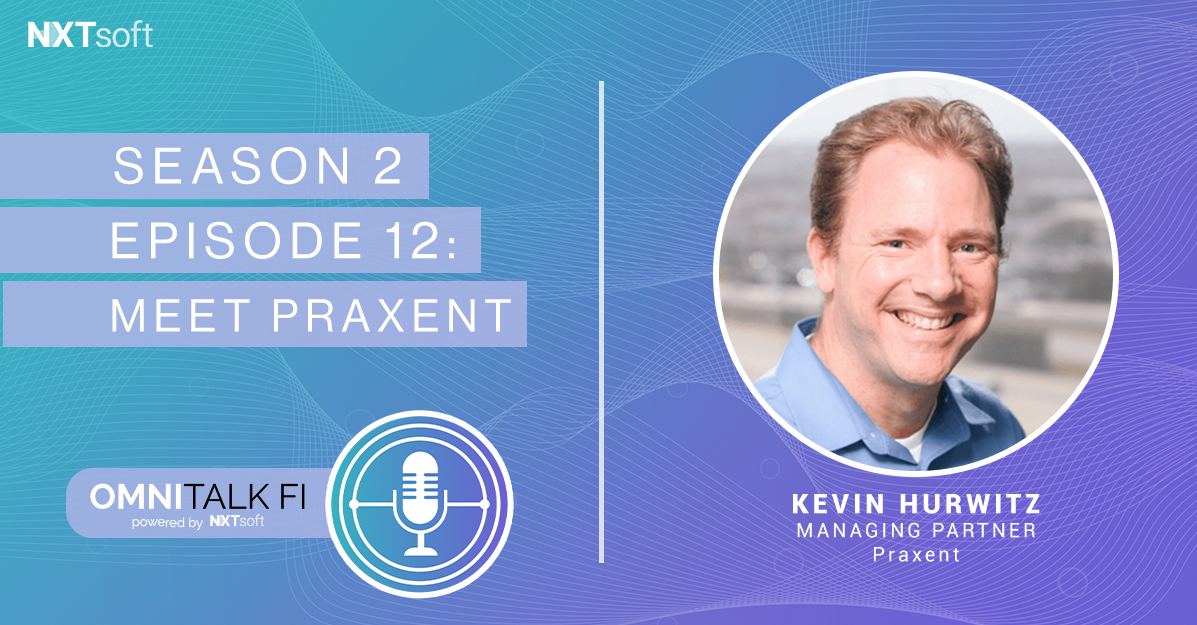On this week’s episode of OmniTalkFI our guest is Kevin Hurwitz, Managing Partner at Praxent. Kevin introduces us to his company and explains how Praxent is helping provide a more modern, intuitive digital experience to its customers.
About Praxent – Praxent is a fintech design, engineering, and implementation partner. We work with fintechs by taking on the last-mile, one-off, client services work that is preventing them from onboarding new customers and blocking their revenue so that their product team can stay focused on the roadmap. Praxent specializes in product extensions, third-party integrations, product implementations, and specialized staffing of fintech design and engineering expertise.

Kevin Hurwitz, Managing Partner, Praxent – Kevin Hurwitz has more than 20 years of experience delivering software solutions for more than 250 organizations. He has been a part of four professional services organizations including Hitachi Consulting, Pariveda Solutions, Headspring where he served as the Chief Architect and EVP of Client Service for seven years, Better Insights, and most recently Praxent where he serves as Managing Partner. At Praxent, Kevin oversees client services providing strategic and technical oversight to all client engagements to ensure we develop quality products and exemplary client experiences.
For more information about how to become a NXTsoft strategic partner, visit https://www.nxtsoft.com/contact or call 1-800-915-3381
Amy Rice: On today’s episode, I have Kevin Hurwitz. He’s the Managing Partner for Praxent. Kevin has more than 15 years of experience delivering business software solutions to more than 150 organizations. Kevin is responsible for the delivery of their innovative web and mobile-based software solutions. He provides strategic and technical oversight to all client engagements to ensure that they develop quality products and exemplary client experience.
Kevin is here today to tell us more about what Praxent does and how they’re helping financial institutions capitalize on opportunities within the marketplace. How are you doing, Kevin?
Kevin Hurwitz: I’m doing fantastic. Thank you, Amy.
Amy Rice: Awesome. Thanks so much for joining me today. I’m really excited to learn more about your company and what you do and also, kind of what you see happening in the future, so we’ll go ahead and get started.
The first question is can you tell our listeners what Praxent does and maybe some highlights from the history of your company?
Kevin Hurwitz: Sure, of course. Well, first of all, I just want to thank you for hosting me and by extension, Praxent on Omni Talk.
So Praxent partners with financial institutions and FinTechs to extend, integrate, and implement FinTech products. The company was founded about 21 years ago by my business partner, Tim Hamilton, and over the years, we’ve worked in every industry, but we’ve made the decision to verticalize to financial services a few years ago and today, again, work primarily with FIs and FinTechs.
Just to give you a sense or an example, when we were doing work with FI and FinTechs, it could be something as extensive as implementing a banking as a service product to launch a new digital bank brand, or it could be something as straightforward as adding a new feature to an FI’s website that integrates, for example, its loan origination system. So it could be anything from a complete digital transformation to, really, a small extension leveraging modern cutting-edge FinTech products.
Amy Rice: That sounds really interesting. Could you speak to how NXTsoft and Praxent supports financial institutions?
Kevin Hurwitz: Of course, I’d be happy to. So NXTsoft is, as many of your listeners likely already know if they’re listening to this podcast, makes integrating FinTech products to the core much more straightforward than it’d otherwise be because NXTsoft has developed pre-built connectors to nearly every core processor. I think, by last count, I heard that that was 37 core processors that made up the vast majority of the market.
So for us at Praxent to fulfill our mission of extending, implementing, and integrating FinTech products, we wanted to partner with NXTsoft so that we could offer much more holistic solutions to the FIs and FinTechs we serve. Specifically, we help FIs and FinTechs deploy innovative financial technology to community financial institutions and accelerating that process with prebuilt connectors is absolutely critical because otherwise without it, the initiative could just be too time consuming, too expensive for a CFI to undertake.
Amy Rice: I know that we are extremely excited about this partnership, and it’s companies like you that we really build off of, so we’re excited about what we’re going to do in the future and building the relationship with Praxent. Speaking of the future, what do you think the industry needs to be ready for next?
Kevin Hurwitz: Absolutely. That’s a fantastic question. We really see there are certainly numerous trends we could highlight, but there are really two clear trends that we see affecting community financial institutions.
The first is probably not a surprise to anybody. It’s this digitization of the customer experience, and that has been greatly accelerated by the pandemic. People who were forced to learn how to open bank accounts online to bank online are largely not going to revert to conducting routine tasks in person at a branch because they’ve likely discovered that digital is more convenient for most of their needs. So this has been a big debate in numerous thought leadership channels as to what would happen after the pandemic subsided, and fortunately, we’re seeing that today, but we think the digitization of the customer experience was a preexisting trend and one that will continue unabated through the pandemic. So that’s one unique challenge is that banks and credit unions need to be as good at serving their customers digitally as they’ve traditionally been in serving them through branches.
And then the second is the emergence of open banking, and we’re seeing just a huge trend and proliferation of open banking driven in part by [inaudible 00:05:12] gradually opening up their architectures. This isn’t something, obviously, that’s happened overnight, but it is a trend that we see continuing and accelerating even. And that’s really driving the adoption or sorry, the disruption in the banking space by the rapid growth of direct-to-consumer brands.
So some examples of those: PayPal, Square, Venmo, and Revolut. And so what these brands are doing is that they’re silently taking market share from CFIs by having those consumers open their second, third, fourth accounts. This is something we learned a lot about, actually, at the AFT Conference, Association of Financial Technology Conference just last week that consumers often consider CFIs to be their primary bank, but increasingly, they’re seeing these other direct to consumer brands being their secondary and tertiary brands, and it’s only a matter of time before that switches, and these consumer offerings become primary to many consumers.
So those are two trends, the digitalization of the customer experience and then open banking standards pushing the direct-to-consumer brands that we think that all CFIs really need a strategy to address.
Amy Rice: Those are definitely two trends that we’ve also seen in the market. The pandemic really pushed the digital time clock forward which is a good thing for consumers but sometimes can be a bad thing for financial institutions just because they had a timeline set for when they were going to digitize and that kind of got pushed forward. And then also open banking is a very good one that consumers want what they want, and they want it now. So I think that from a consumer standpoint, those two things are definitely beneficial and helpful to just making life easier.
Can you talk about what opportunities you are seeing for financial institutions now and how Praxent can help them capitalize on those opportunities?
Kevin Hurwitz: Absolutely. So to go along with the two trends we’re seeing, we see two opportunities as well. These are, of course, broad strokes opportunities.
The first is to establish a better niche with an online presence. So the digitization of banking is decreasing the importance of geographic location is a niching strategy. So if you look at something as broad as Porter’s Five Forces Models, niching, traditionally, has been at a local or geographic level. But with the digitization of the experience, that’s leading many banks and credit unions to instead focus on niches they can pursue across a broader geography, such as specialty brands to serve medical professionals or farmers.
From a technology perspective, we’re seeing an increasing number of options being made available by core providers and neo-cores to stand up new digital banking brands. Praxent, specifically, can help with the branding, UX design, and implementation of those cores and neo-cores for establishing a digital banking brand. And so that’s one opportunity we see is very interesting and will continue. We’re seeing CFIs particularly into this, as well as some larger brands and even some not currently in the financial services space working with sponsor banks to do that same kind of implementation.
The other type of opportunity we see is really in turning open banking on its head and using it to your advantage as a CFI. And this was something that was, I would say, almost a rallying cry, if you will, for the AFT event that took place last week where all of the FinTechs that are in attendance really were talking openly about how they can work with and how we, as Praxent and NXTsoft, can work with community financial institutions to retain control of their customer relationships by allowing or taking advantage of open banking standards to integrate the latest and greatest FinTech products to create a differentiated customer member experience.
How to do that, really, is to take advantage of that great service you’re already offering, but then be competitive on the digital side as well by taking advantage, again, of all the technology that’s hitting the market today.
Amy Rice: So Kevin, could you speak about a specific example where you’ve helped a financial institution convert more leads into actual customers?
Kevin Hurwitz: Absolutely. I’d be happy to talk about an example of that. Actually, when I was talking about a niching strategy, we’ve been working over the past couple of years with a community financial institution that has established a new digital brand specifically for credit building. And the entire account experience is digital online, so you can convert as a client or as a customer through online know your customer flow.
Kevin Hurwitz: And the challenge they were having was that they were having more drop-offs than they wanted to have through that initial account opening experience. And that’s a common challenge with digital banking. You’re asking a lot of personal information like for a social security number. You’re asking for information, ultimately, to fund an account, to conduct credit checks. And every time you’re asking one of those questions, you’re either confusing the end-user, or you’re sending them away for lack of [inaudible 00:10:42].
And so what we did in that case was we worked with this regional financial institution to do a heuristic evaluation of their online account opening flow. And what that meant was looking at every single screen and evaluating it against 10 usability best practices published by the Nielsen Norman Group. And for each of the issues we discovered, we ranked them on a severity from zero, which would actually be a good experience, to five which is a severe problem.
And we found, in particular, a couple of fours, no fives, but a couple of significant issues. But once we addressed them, significantly improved conversions through the experience. And one of them was as simple as adding a Cancel link to a modal so that a consumer could stop a particular process before having to go through it and ultimately get frustrated or not be able to task complete.
And so that’s an example of working really directly with financial institutions to optimize their use of FinTech.
Amy Rice: Being in marketing, that’s extremely interesting to go through the process as a consumer and figure out fault points of, “This is just too much. I’m just going to scrap it.” So that’s a really beneficial, interesting way of helping financial institutions to convert more. If the person started filling it out, then they’re obviously interested, so there must be some point in the process where they were just like, “This is not worth it,” or, “I’m too confused,” and it’s an interesting way to help financial institutions convert more leads into actual customers.
Kevin Hurwitz: If I could say one more thing about that, Amy, we look at that kind of heuristic evaluation as one leg of a three-legged stool. The other two legs we’ve worked with the same CFI on which are customer research. So actually interviewing customers that drop out of an experience to understand exactly what was going on in their minds and why they ultimately abandoned the experience.
And then the other is a review of analytics. And so that review of analytics helps you pinpoint exactly where the trouble spots are, and that research and heuristic evaluation can then get to the bottom of exactly where the challenges are so they can be addressed through a better user experience design.
Amy Rice: That makes sense. To me, that’s really interesting as far as… I mean because you never know why somebody dropped out, but if you can go in and analyze it, that could definitely help reel that one in.
My next question is kind of in line with the previous question that I asked, and that’s why did you choose NXTsoft as an integration partner?
Kevin Hurwitz: Absolutely. Another good question. So when an FI, in our experience, decides to take advantage of a new FinTech product, they’re often responsible for financially developing the necessary core integrations and integrations to other auxiliary FinTech systems. And as I’d mentioned briefly before, this is both expensive and time consuming and could ultimately prevent financial institutions from taking advantage of all the opening up of core banking standards and the ability to integrate more innovative technology and specifically, core providers heavily restrict access to their integration sandboxes because they want to ensure a high degree of accuracy and security in integrations that are built to their product.
So for well-meaning purposes, they put that standard fairly high, that bar fairly high, and NXTsoft provides value, so the FinTechs are… sorry, the FinTechs and the FIs we work with by having cleared those bars already, by having worked with those core providers, forming those relationships. And ultimately, years before we ever engaged with a FI or a FinTech, having jumped through all those hoops so that those partners we work with can seamlessly complete integration.
The other reason we chose NXTsoft as a partner, frankly, is just that NXTsoft treats every relationship it forms as a true partnership, and that has been clear over and over again. And so in addition to the technical capabilities the organization brings, it also brings a real spirit of partnership to, again, every relationship it forms.
Amy Rice: I know that our view on partnerships is if you succeed, then we’ll succeed. So we’re really into doing things together, joint marketing, joint social media posts, all of that, and so we’re really excited about this partnership and like I said, what we can do in the future.
I just have one last question for you, and it’s kind of a fun question that I ask everyone. Before the pandemic, I was kind of an avid traveler. I liked to go to new places and see new things. So I’ve kind of been missing that the past year and not being able to travel. So I’ve been asking people what their favorite place to travel to is, so then that way I can figure out new places to go when everything starts opening up again, and we can go outside of the country. So I’d like to know what your favorite place is that you’ve ever traveled.
Kevin Hurwitz: Absolutely. Unlike you, I haven’t been very many places, but I have taken three trips to Israel, actually, and really, really enjoyed my time there. I think one of the reasons I love it so much, personally, is I’m kind of a history buff. I love reading about world history and growing up in central Texas, if you found a building that was constructed in the 1800s, it’s usually the late 1800s, and it was considered ancient, something that you almost feel like you’d breathe on, it would fall over.
But when you’re in Israel and particularly, when you’re in Jerusalem, the history is just everywhere there. You can, for example, go up to this place called Masada which is an ancient fortress, and you can see Roman roads and the outline of Roman forts from 2,000 years ago. And so it’s just an incredible place to experience history, and I think that’s what I love so much about going there the few times I have.
Amy Rice: No, it sounds like a very… I don’t want to say historic because it’s more than that, but it sounds like an amazing place.
Kevin Hurwitz: It’s definitely different than any place else I’ve been, so for that, it’s a good experience.
Amy Rice: Awesome. Well, thank you so much for joining me, Kevin.
Kevin Hurwitz: Absolutely. It was my pleasure.









